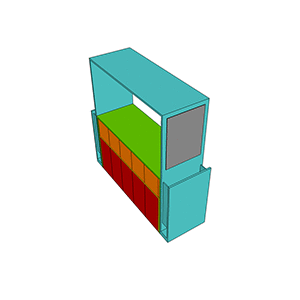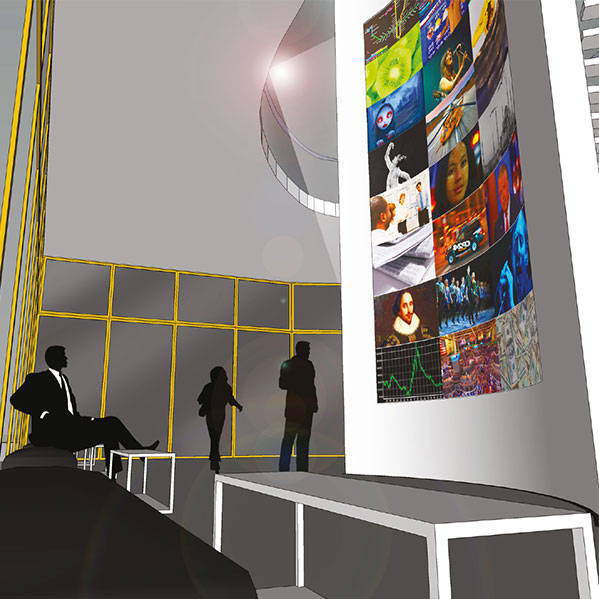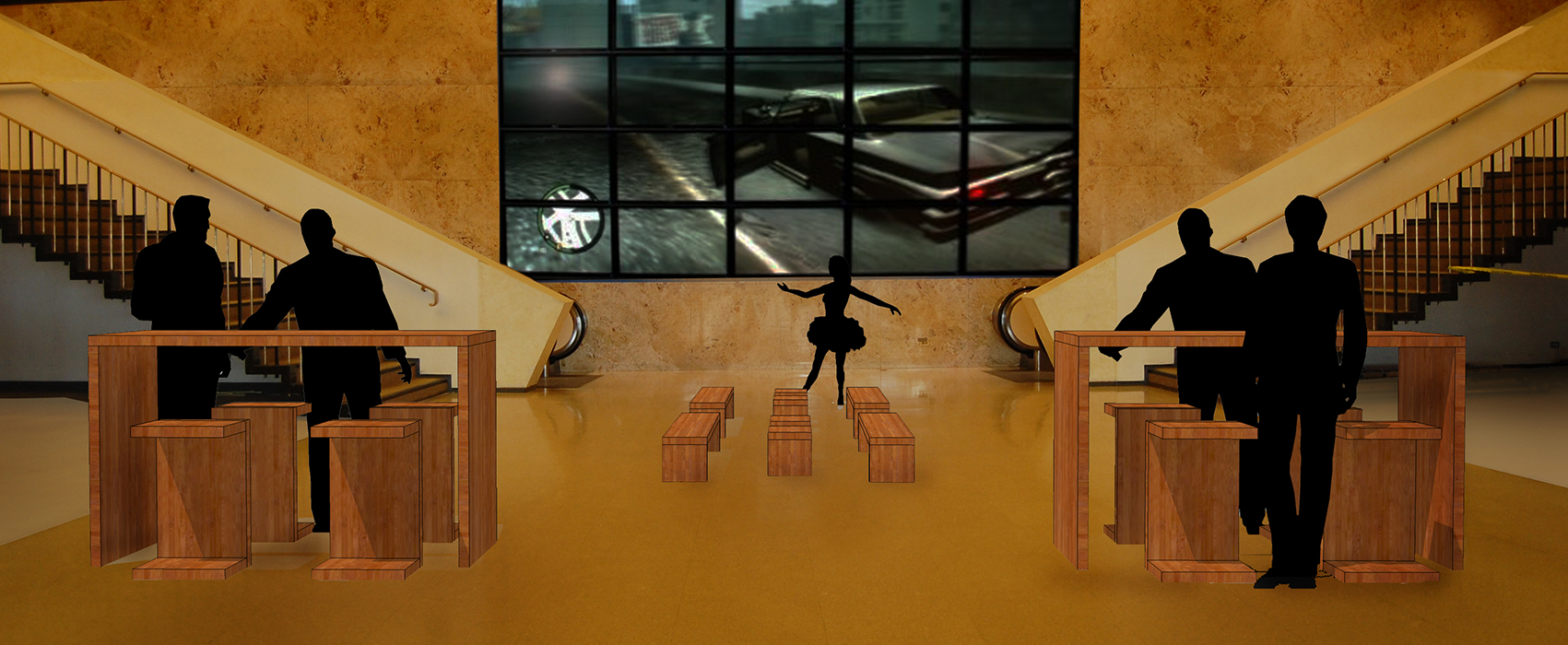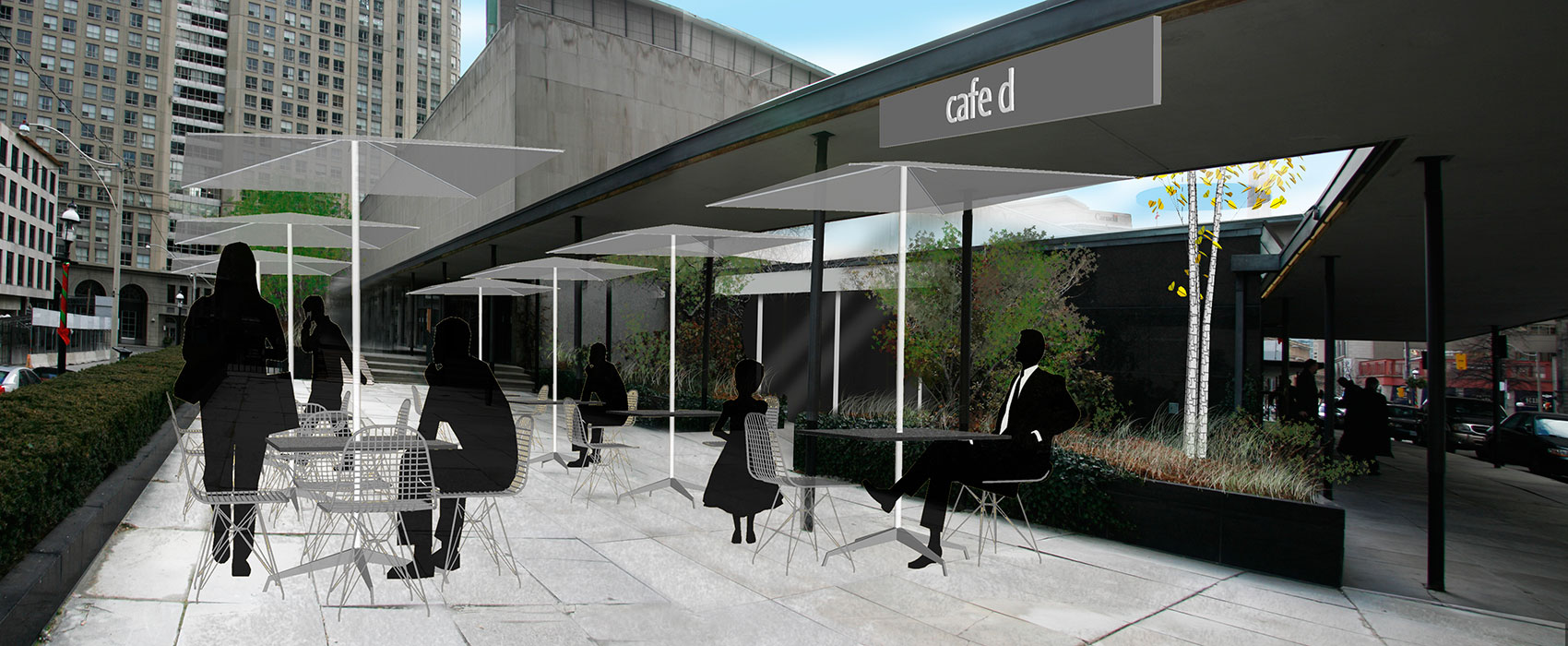Sony Centre for the Performing Arts Design Charrette
Overview:
In the fall of 2008, the IwB conducted a week-long charrette with the Sony Centre for the Performing Arts, exploring new applications for the Centre’s interiour and exteriour spaces. At the time, the Centre was undergoing many changes, including the departure of its flagship tenants, the National Ballet and Canadian Opera Company. The Sony Centre needed to build on its reputation for high quality performances and history of loyal audiences and evolve into a facility that supports the changing entertainment interests of the 21st century.
Thus, the charrette was an opportunity for the Sony Centre to redefine itself as both a national and international space for the fine and performing arts that integrated cutting-edge technological, multimedia, and digital programs. To this end, the IwB worked with Sony Centre management to develop new programs and features, like furnishings, fixtures, and convertible environments, that would draw on market opportunities within the Centre’s identified audience groups, and generate additional revenue, as well as day traffic.
Project Goals:
The Sony Centre Charrette challenge encompassed branding, programming, long-term business planning, cultural development, and needed to consider the impact on the City of Toronto’s arts community, residents, and visitors. It was essential to also consider the architectural history of the building itself, the juxtaposition of modern and contemporary aesthetics, the preservation and promotion of Canadian culture, and the intersection of arts and technology.
__
The Sony Centre needed to bridge the gap between its cultural and architectural heritage and the changing landscape of digital technology.



The Sony Centre for the Performing Arts Design Charrette:
The Sony Centre for the Performing Arts has a history as a leader in the arts culture of Toronto. Built in 1960, in downtown Toronto, the Sony Centre was due for renovations beginning in 2008. The Centre’s board began thinking about how infrastructural improvements could be complemented with new programming.
Recognizing that popular entertainment was shifting from traditional performance-based arts to new media arts such as video, film, and interactive digital content, the Centre wanted to take on the role of a multicultural and multimedia arts and entertainment hub. The Sony Centre wanted to create opportunities to attract contemporary artists interested in new media and build upon its history of excellence by expanding the formats it supported while nurturing emerging forms of digital art.
Thus, the main aim of the charrette was to increase Sony Centre’s ability to facilitate arts production and audience experiences that are interactive and digitally enhanced. This move would also support growth in the fine and performing arts industries and would ultimately achieve the objectives of increasing audience draw, developing long-term relationships with sponsors, and generating new revenue streams in addition to ticket sales. Simultaneously, the Centre’s board was concerned with how to best manage the dynamic between preservation and progress.
On the whole, the Sony Centre Charrette aimed to complement the renovation plans by imagining program options and design concepts for day utilization of its lobby spaces based on new market opportunities and develop an annual program calendar designed to attract diverse audience groups.
The charrette was extremely successful at generating many new design concepts. Ultimately, the Institute choose to ground its design strategy in the goal to merge the Centre’s reputation as a performance arts hub with Sony’s reputation as a digital entertainment leader. The designs proposed during the charrette were developed as phased multi‐year pilot projects that at any time could be further refined to target Toronto’s growing digital arts culture.
Project Outcome:
Brainstorming sessions and client reviews produced a wide variety of ideas including: a list of potential clients in the digital arts field (corporations, events and festivals); precedents for digital centres, both locally and internationally; program concepts and utilization options for the Centre’s lobby and basement spaces; risks and returns of various program opportunities; design schematics for the spatial layout and furnishings required to support the proposed
programming; feasibility and practicality of the programming and long-term business planning; cultural development and impact on the City of Toronto’s arts community, residents and visitors; and compatibility with the Centre’s existing brand.
Through a process of idea generation and refinement, a final strategy was chosen and expanded. This strategy was a proposal for a Digital Innovation Centre that would incorporate the Centre’s reputation as a performance arts hub with Sony’s reputation as a digital entertainment leader, enabling it to facilitate arts production and audience experiences that are interactive and digitally enhanced.
Towards this goal, the teams choose and presented four distinct programs to Sony Centre’s management, which are summarized below.
For more information on this project see our Sony Centre for the Arts Design Charrette publication (showing the whole process) and/ or the Executive Summary.
Summary of the final charrette concepts:
Centre Spot: A gala and event lobby that highlights Sony technology
Centre Spot was a proposal for a digitized stage that uses Sony technology to extend and enhance the entertainment experience before and after the main event happening on stage. The objective of this program was to influence ticket sales by providing local communities with a taste of the Centre’s main stage shows.
Centre Spot would be open to a walk-in audience prior to main stage events, and would host special pre-show programming linked to the feature production. This program could be presented by the show producer, or by a local community group, and could incorporate live and digital content. The pre-show could also include an audio-visual light display, which demonstrates how Sony technology was used to enhanced the theatre experience.
Digit: Toronto’s Centre for Digital Arts and Technology
Digit aimed to attract new audience groups for the Sony Centre, while extending and reinforcing its brand identity. Strategic partnerships, hosting industry lectures on current topics, and offering a workshop space to artists for software testing or the production of new work would allow the Centre to make the theatre relevant to audiences who are looking for entertainment that incorporates both artistic and technological elements.
The Digit proposed program included gallery, learning and event spaces with breakout rooms and state-of-the-art technological infrastructure. A gallery could be curated by an advisory committee, with representatives from educational institutions and technology companies, artists, and digitally savvy people.
In the proposal, a learning space is suggested that could be operated by one of the educational partners in collaboration with the Director of Technology. Here school groups could be hosted for full or half-day field trips. A marketing specialist who would recruit corporate events and festivals within the digital arts and entertainment industry could manage the event space.
Café D: A stop for the latest in performing arts, entertainment & digital media
This concept for a café and bookstore would be operated by one or more retail tenants, and would physically extend the Centre into the community during the day. With glass windows that expose parts of the main lobby, the café could help to open the Centre’s doors to the streetscape while bringing a sense of transparency of the theatre’s ongoing programs to its audience.
As a resource for literature on the fine, performing and digital arts, Café D would reinforce the Centre’s brand and become a meeting spot for local residents and business people, and might host events such as interviews with show directors, book readings and signings, and roundtable discussions. In addition to food, beverages and books, Café D would sell show tickets and merchandise.
The City Centre: An information & ticketing portal
This portal would be an information centre and juice bar with digital ticket wickets and timely broadcasts about the latest news in performing arts and entertainment. Acting as a kind of ‘Ticket Master,’ the City Centre would be a place where anyone can come to book tickets for municipal and provincial cultural events. It could partner with the City of Toronto and the Province of Ontario to provide digital access to tickets and information on cultural events hosted by the City or Province.
Partnering with a broadcaster such as CTV, the City Centre would televise up-to-date arts and entertainment news, as well as content specific to the Centre’s shows and other cultural topics.
Project Credits:
IwB staff & faculty
Luigi Ferrara
Silvio Ciarlandini
Michelle Hotchin
Priscilla Li
Perin Ruttonsha
Connor Malloy
Michael McMartin
Teresa Miller
Mark Stevens
Ron Guitar
Fernando Lopez
Andrea Mastrandrea
John Montesano
Alexi Parizeau
Project Tags:
Toronto Charrette: Responsive Building, Chicago City Spaces Charrette
“The Centre could be a signature space if it became a digital extension of the festivals – a virtual ‘plug & play’ outlet and a portal to international communities.”
– John Montesano, Vice President TLN, quoted in Sony Centre for the Performing Arts Design Charrette publication



